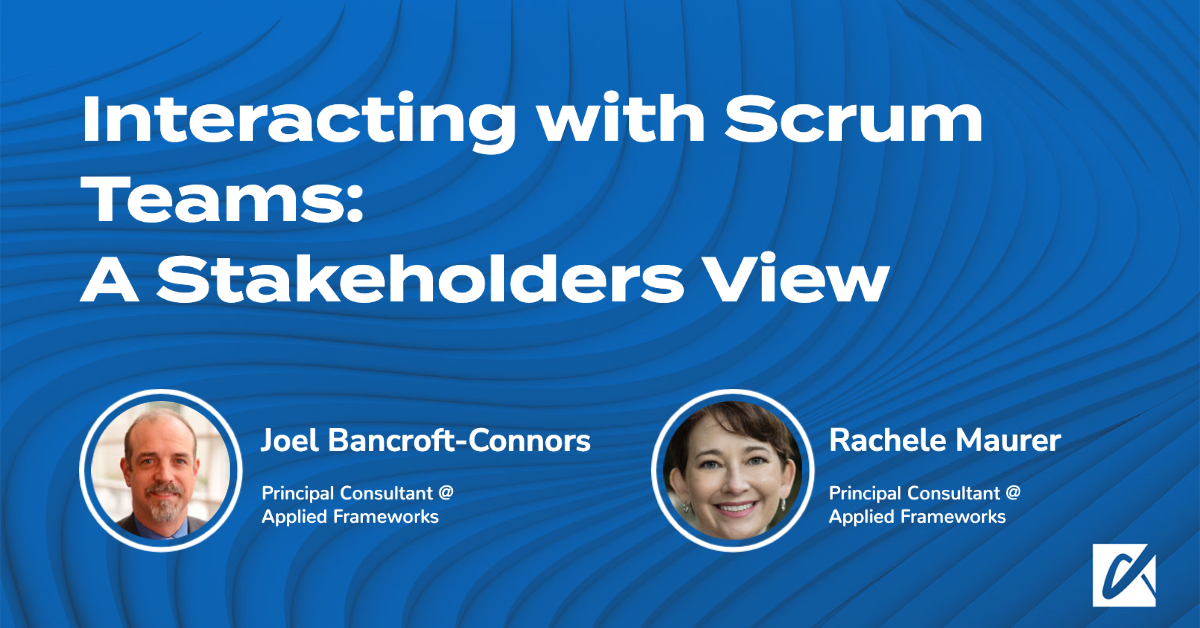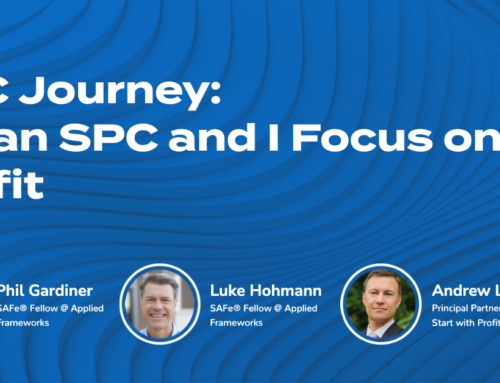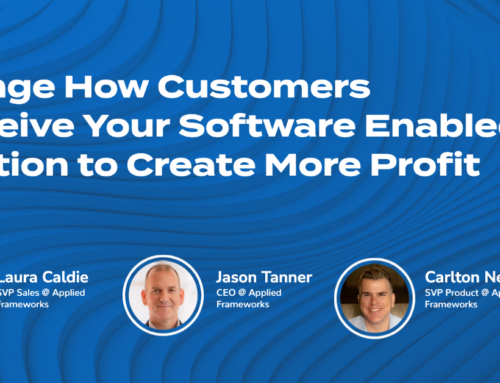Interacting with Scrum Teams: A Stakeholders View – Check out the recording!
Are you in Marketing, Sales, or Finance, and your IT organization has used the words “Agile,” “Lean,” “Value Stream,” or “Optimizing Flow” recently?
Are they using Scrum or Kanban?
Do you, as a stakeholder, know how you should interact with them now or why you should care?
Join us for our hour-long interactive webinar, Interacting with Scrum Teams, where Certified Scrum Trainer Joel Bancroft-Connors and SAFe Implementation Expert Rachele Maurer introduce you to what you need to know about Scrum and Agile and explain why it’s in your best interest to interact with the teams using it.
Are you interested in learning more? Please contact us to learn more about how our consultants can help your organization or Schedule a meeting with our Client Delivery Team.
Questions & Answers
With our teams we have found that it is critical for the Program Product Owners communicate closely with the matrixed functional leads to create alignment to create the value.
Joel: Yes, a Product Owner has many Stakeholders and needs to balance the needs of all of them.
Rachele: Definitely!
Does a scrum master replace the program manager?
Joel: At the individual Scrum Team level, there is no project or program manager. Instead, the responsibilities associated with project management are aggregated across the Scrum team. For example, the Product Owner owns the budget, milestones, and stakeholder reporting, the Developers own quality reporting, short-term deliverable status and the Scrum Master owns facilitation.
Project Managers in organizations moving to Agile and Scrum have three common career paths. They can lean into servant leadership and step into the role of the Scrum Master, they can lean into the product and step into the role or the Product Owner, or they can step back from the team and into an Agile Program Management type role, such as the Release Train Engineer found in Scaled Agile.
Rachele: SAFe has both the roles of Scrum Master at the team level, and the Release Train Engineer (RTE) at the program/release train level. RTEs are servant-leaders that keep the train moving smoothly. It helps to think of them as a Scrum Master of Scrum Masters.
What would be the expectations where an organization has only a product manager and no product owner?
Live Answer: You’d work with the product manager. However, the idea of having teams with no product owner is a big risk – I’ve seen that sink teams multiple times. I’d really encourage the organization to reconsider that position.
Joel: The product manager needs to recognize that for the Scrum Team to be effective, they need work closely with the team. Leaning into Principle 4 of the Agile Manifesto, “Business people and developers must work together daily”, the product manager needs to be heavily engaged with the Developers and own the Product Backlog.
Rachele: What I said in the session. Maybe a little louder! Teams not having someone work with them directly as a Product Owner might be the biggest struggle I see when I coach teams. They end up guessing at priorities and at work, they don’t get the business-focused feedback they need, and they veer off direction. Product Managers working with a program often don’t have the bandwidth to properly work with a team as a Product Owner as well.
So its safe to assume-Stakeholder-Product Owner-Scrum Master-Scrum Team vs Stakeholder-Project Manager?
Joel: Agile promotes greater transparency and openness. This means we connect stakeholders directly with the Scrum Teams in order to ensure that the needs of the Stakeholders are met. Product Owners work hand in hand with Stakeholders to define the Product Goal, the roadmap and refine work in the Product Backlog. The Developers have access to the Stakeholders both in defining the work they are asked to do and to give direct feedback on the work completed. Scrum Masters have access to Stakeholders to be able to make impediments visible and to help them to get more value from Scrum.
Rachele: Stakeholders will work closely with Product Owners (and Product Managers at scale), yes, but it’s a great idea for them to take advantage of other opportunities to be involved. Sprint Reviews give stakeholders the chance to see working products on a regular basis. They can ask questions, provide feedback, get ideas, and interact with the whole Scrum Team. At scale, System Demos provide an opportunity to see integrated completed work.
Neither Scrum not SAFe have a project manager role. Instead, there’s a Product Owner to be champion the product’s success and a Scrum Master to champion the team.
Are SAFe Scrum Teams different than Scrum Teams that are not leveraging the SAFe Framework?
Joel: The foundational principles are the same whether the Scrum Team is a single team or part of a Scaled Agile Release Train (ART).
The primary difference is that Scrum Teams in an ART have an additional layer of planning and coordination that allows them to work with other teams toward a common value and quality goal.
One thing to remember with Scaling efforts is to remember the team. I’ve seen scaling run into challenges because the teams were not well supported and did not have good Scrum (or Kanban) practices. The best strategy and plans are challenged with the teams can not make and meet commitments.
Rachele: I often call the teams the heart and soul of Agile, regardless of framework. If you don’t have someone to do the work, it’s just a lot of people talking about work. Joel is absolutely right: support the teams if you want success. “Give them the environment and support they need,” Agile principles tell us, “and trust them to get the job done.”
Similarities: Agile values! Scrum Teams working in SAFe organizations are still Scrum Teams. Their day-to-day approaches and work will be very similar, especially at the sprint level.
Differences: ART/Program-level events. Scrum Teams – and everyone else in the release train – participate in PI Planning at the start of a Program Increment, and in the Inspect & Adapt event at the end of a PI.
Scrum Masters attend a Scrum of Scrums, and Product Owners attend a PO Sync – or both attend an ART Sync to keep the communication flowing. Team members should surface any cross-team dependencies or communication needs.
There are some differences in terminology, but that’s cosmetic. “Sprint” or “Iteration,” they’re still Scrum Teams.
Are you interested in learning more? Please contact us to learn more about how our consultants can help your organization or Schedule a meeting with our Client Delivery Team.






